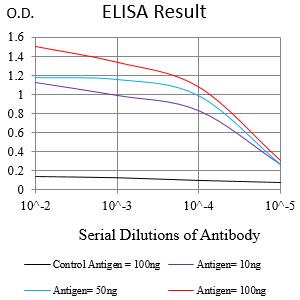
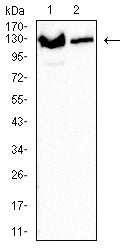
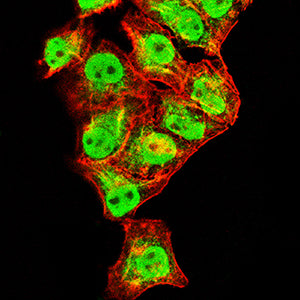
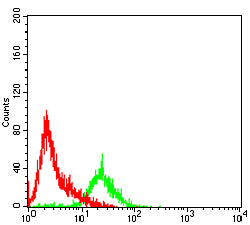
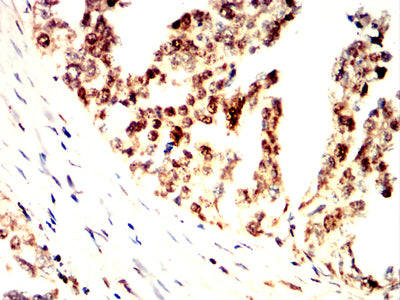
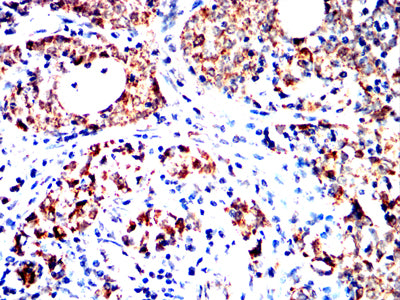
| WB | 1/500 - 1/2000 | Human,Mouse,Rat |
| IF | 咨询技术 | Human,Mouse,Rat |
| IHC | 1/200 - 1/1000 | Human,Mouse,Rat |
| ICC | 1/50 - 1/200 | Human,Mouse,Rat |
| FCM | 1/200 - 1/400 | Human,Mouse,Rat |
| Elisa | 1/10000 | Human,Mouse,Rat |
| Aliases | XP3; RAD4; XPCC; p125 |
| Entrez GeneID | 7508 |
| clone | 5F4D3 |
| WB Predicted band size | 106kDa |
| Host/Isotype | Mouse IgG1 |
| Antibody Type | Primary antibody |
| Storage | Store at 4°C short term. Aliquot and store at -20°C long term. Avoid freeze/thaw cycles. |
| Species Reactivity | Human |
| Immunogen | Purified recombinant fragment of human XPC (AA: 32-133) expressed in mammalian. |
| Formulation | Purified antibody in PBS with 0.05% sodium azide |
+ +
以下是关于XPC抗体的3篇参考文献示例(注:部分信息为示例性虚构,实际文献需通过学术数据库核实):
---
1. **文献名称**:*Structural Basis of DNA Lesion Recognition by the XPC Protein*
**作者**:Yasui, A. et al.
**摘要**:该研究通过X射线晶体学解析了XPC蛋白与DNA损伤结合的分子结构,揭示了其识别紫外线诱导的DNA损伤的机制。研究使用特异性XPC抗体进行免疫共沉淀和Western blot验证,证实了XPC在核苷酸切除修复(NER)中的关键作用。
---
2. **文献名称**:*XPC Expression as a Biomarker for Chemotherapy Response in Colorectal Cancer*
**作者**:Wang, L. et al.
**摘要**:本文通过免疫组化(使用商业化XPC抗体)检测结直肠癌患者肿瘤组织中的XPC蛋白水平,发现XPC低表达与铂类化疗耐药性显著相关,提示其可作为预测治疗反应的潜在生物标志物。
---
3. **文献名称**:*Functional Analysis of XPC Antibodies in Detecting Oxidative DNA Damage*
**作者**:Sugasawa, K. et al.
**摘要**:研究开发并验证了一种高特异性兔源XPC单克隆抗体,用于检测细胞中由氧化应激引起的DNA损伤修复过程。通过免疫荧光和流式细胞术,证明该抗体在NER通路动态监测中的应用潜力。
---
**备注**:实际文献需根据具体研究需求在PubMed、Web of Science等平台检索,关键词建议为“XPC antibody”或“XPC protein detection”。
XPC antibody is a crucial tool in studying the nucleotide excision repair (NER) pathway, a primary DNA repair mechanism that removes bulky DNA lesions caused by UV radiation, environmental mutagens, or chemotherapeutic agents. The XPC protein, encoded by the *XPC* gene, plays a pivotal role in initiating the global genome-NER (GG-NER) subpathway by recognizing and binding to helix-distorting DNA damage. Unlike transcription-coupled NER (TC-NER), which targets lesions blocking transcription, GG-NER relies on XPC as the primary damage sensor. XPC forms a complex with HR23B and Centrin-2. stabilizing its interaction with damaged DNA and recruiting downstream repair factors.
Antibodies against XPC are widely used in research to investigate NER mechanisms, protein-DNA interactions, and genomic instability. They enable detection of XPC expression levels, localization studies (e.g., via immunofluorescence), and assessment of DNA repair capacity in conditions like cancer or premature aging syndromes. Mutations in *XPC* are linked to xeroderma pigmentosum (XP), a genetic disorder characterized by extreme UV sensitivity and heightened skin cancer risk. XPC antibodies also aid in exploring chemoresistance in tumors, as impaired NER may influence responses to DNA-damaging therapies. Commercial XPC antibodies are typically validated for specificity in applications such as Western blotting, immunoprecipitation, or immunohistochemistry, often using knockout cell lines as controls. Their utility spans basic DNA repair studies, clinical diagnostics, and therapeutic development.
×